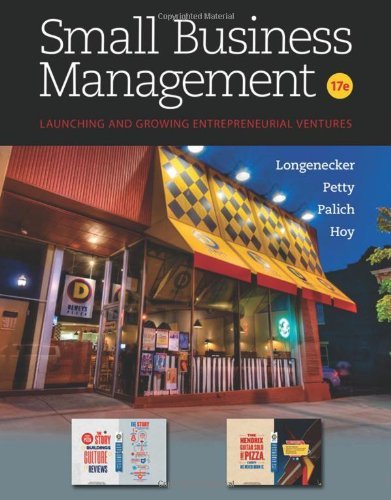This is completed downloadable of Small Business Management Longenecker 17th Edition Test Bank

Product Details:
- ISBN-10 : 1133947751
- ISBN-13 : 978-1133947752
- Author:
Realize your dream for small business success with this market-leading book. SMALL BUSINESS MANAGEMENT: LAUNCHING AND GROWING ENTREPRENEURIAL VENTURES, 17E provides the practical concepts, entrepreneurial insights, and comprehensive resources you’ll find essential both now and throughout your management future. SMALL BUSINESS MANAGEMENT delivers solid coverage of the fundamentals of business management as it teaches you not only how to start a business, but also how to manage, grow, and harvest a business. This market leading text places you in the role of decision maker, allowing you to immediately apply what you’ve learned to current challenges in today’s small businesses. The book’s thorough emphasis on building business plans ensures that you can effectively create, manage, and analyze a plan for your own venture. Unforgettable examples, exciting video cases, and coverage of the most current developments in business management today keep this engaging text as current and practical now as it was when it led the market in its first edition 50 years ago. Each edition builds upon past strengths with new innovations and breakthrough developments. SMALL BUSINESS MANAGEMENT: LAUNCHING AND GROWING ENTREPRENEURIAL VENTURES, 17E offers the insights and practical principles that you’ll reference again and again throughout your business career.
Table of Content:
- Ch 1: The Entrepreneurial Life
- 1-1: Small Size but Large Significance
- 1-2: Small Business and Entrepreneurial Opportunity: The Same or Different?
- 1-3: Entrepreneurial Qualities: No Big Ego Required
- 1-4: Your Motivations for Owning a Business
- 1-5: The Competitive Edge of Entrepreneurs
- 1-6: Building an Entrepreneurial Legacy
- 1-7: Where to from Here?
- Ch 2: Integrity and Ethics: Foundations for Success in Small Business
- 2-1: What is Integrity?
- 2-2: Integrity and the Interests of Major Stakeholders
- 2-3: The Challenges and Benefits of Acting with Integrity
- 2-4: Building a Business with Integrity
- 2-5: Small Business and the Natural Environment
- Ch 3: Starting a Small Business
- 3-1: Developing Startup Ideas
- 3-2: Using Innovative Thinking to Generate Business Ideas
- 3-3: Using Internal and External Analyses to Assess New Business Ideas
- 3-4: Selecting Strategies That Capture Opportunities
- 3-5: Screening New Business Ideas
- 3-6: Is Your Startup Idea Feasible?
- Ch 4: Franchises and Buyouts
- 4-1: What is a Franchise?
- 4-2: The Pros and Cons of Franchising
- 4-3: Evaluating Franchise Opportunities
- 4-4: Buying an Existing Business
- Ch 5: The Family Business
- 5-1: What is a Family Business?
- 5-2: Dynamic Family Businesses
- 5-3: Family Roles and Relationships
- 5-4: Good Governance in the Family Firm
- 5-5: The Process of Leadership Succession
- Ch 6: The Business Plan: Visualizing the Dream
- 6-1: An Overview of the Business Plan
- 6-2: Will Writing a Plan Make a Difference?
- 6-3: Preparing a Business Plan: The Content and Format
- 6-4: Advice for Writing a Business Plan
- 6-5: Understanding the Business Model
- 6-6: Resources for Business Plan Preparation
- 6-7: Keeping the Right Perspective
- Ch 7: The Marketing Plan
- 7-1: What is Small Business Marketing?
- 7-2: The Formal Marketing Plan
- 7-3: Marketing Research for the Small Business
- 7-4: Understanding Potential Target Markets
- 7-5: Estimating Market Potential
- Ch 8: The Organizational Plan: Teams, Legal Structures, Alliances, and Directors
- 8-1: Building a Management Team
- 8-2: Common Forms of Legal Organization
- 8-3: Considerations in Choosing an Organizational Form
- 8-4: Specialized Forms of Organization
- 8-5: Forming Strategic Alliances
- 8-6: Making the Most of a Board of Directors
- Ch 9: The Location Plan
- 9-1: Locating the Brick-and-Mortar Startup
- 9-2: Designing and Equipping the Physical Facilities
- 9-3: Locating the Startup in the Entrepreneur’s Home
- 9-4: E-Commerce: Locating a Startup on the Internet
- Ch 10: Understanding a Firm’s Financial Statements
- 10-1: The Income Statement
- 10-2: The Balance Sheet
- 10-3: Viewing the Income Statement and Balance Sheet Together
- 10-4: The Cash Flow Statement
- 10-5: Evaluating a Firm’s Financial Performance
- Ch 11: Forecasting Financial Requirements
- 11-1: The Purpose of Financial Forecasting
- 11-2: Forecasting Profitability
- 11-3: Forecasting Asset and Financing Requirements
- 11-4: Forecasting Cash Flows
- 11-5: Use Good Judgment When Forecasting
- Ch 12: A Firm’s Sources of Financing
- 12-1: Firm Characteristics and Sources of Financing
- 12-2: Debt or Equity Financing?
- 12-3: Sources of Early Financing
- 12-4: Bank Financing
- 12-5: Business Suppliers and Asset-Based Lenders
- 12-6: Private Equity Investors
- 12-7: Government Loan Programs
- 12-8: Where Else to Look
- 12-9: Crowdfunding
- Ch 13: Planning for the Harvest
- 13-1: The Importance of the Harvest
- 13-2: Methods of Harvesting a Business
- 13-3: Firm Valuation and Payment Methods
- 13-4: Developing an Effective Harvest Plan
- Ch 14: Building Customer Relationships
- 14-1: What is Customer Relationship Management?
- 14-2: Outstanding Customer Relationships through Extraordinary Service
- 14-3: Using Technology to Support Customer Relationship Management
- 14-4: Customers as Decision Makers
- 14-5: Understanding Psychological Influences on Customers
- 14-6: Understanding Sociological Influences on Customers
- Ch 15: Product Development and Supply Chain Management
- 15-1: To Grow or Not to Grow
- 15-2: Innovation: A Path to Growth
- 15-3: The Product Life Cycle and New Product Development
- 15-4: Building the Total Product
- 15-5: Product Strategy
- 15-6: The Legal Environment
- 15-7: Supply Chain Management
- Ch 16: Pricing and Credit Decisions
- 16-1: Setting a Price
- 16-2: Applying a Pricing System
- 16-3: Selecting a Pricing Strategy
- 16-4: Offering Credit
- 16-5: Managing the Credit Process
- Ch 17: Promotional Planning
- 17-1: Promotion is Communication
- 17-2: Determining the Promotional Budget
- 17-3: Promotion Using the Internet and Social Media
- 17-4: Personal Selling in the Small Firm
- 17-5: Advertising Practices
- 17-6: Sales Promotion
- Ch 18: Global Opportunities for Small Businesses
- 18-1: Small Businesses as Global Enterprises
- 18-2: The Forces Driving Global Businesses
- 18-4: Challenges to Global Businesses
- 18-5: Assistance for Global Enterprises
- Ch 19: Professional Management and the Small Business
- 19-1: Small Business Leadership
- 19-2: The Small Firm Management Process
- 19-3: Managerial Responsibilities of Entrepreneurs
- 19-4: Personal Time Management
- 19-5: Outside Management Assistance
- Ch 20: Managing Human Resources
- 20-1: Recruiting Personnel
- 20-2: Evaluating Prospects and Selecting Employees
- 20-3: Training and Developing Employees
- 20-4: Compensation and Incentives for Employees
- 20-5: Special Issues in Human Resource Management
- Ch 21: Managing Operations
- 21-1: Competing with Operations
- 21-2: The Operations Process
- 21-3: Inventory Management and Operations
- 21-4: Operations Management and Quality
- 21-5: Purchasing Policies and Practices
- 21-6: Lean Production and Synchronous Management
- Ch 22: Managing the Firm’s Assets
- 22-1: The Working Capital Cycle
- 22-2: Managing Cash Flows
- 22-3: Managing Accounts Receivable
- 22-4: Managing Inventory
- 22-5: Managing Accounts Payable
- 22-6: Cash Conversion Period Revisited
- 22-7: Capital Budgeting Techniques
- 22-8: Capital Budgeting Practices in Small Firms
- Ch 23: Managing Risk in the Small Business
- 23-1: What is Business Risk?
- 23-2: Basic Types of Pure Risk
- 23-3: Risk Management
- 23-4: Basic Principles of a Sound Insurance Program
- 23-5: Common Types of Business Insurance
- Cases
- Case 1: DashLocker
- Video Case 2: PortionPac Chemicals
- Case 3: The Kollection: From Music Hobby to Startup and Beyond
- Video Case 4: Two Men and a Truck/International, Inc.
- Case 5: The Avedis Zildjian Company, Inc.
- Case 6: Hyper Wear, Inc.
- Video Case 7: ReadyMade Magazine
- Case 8: Couchsurfing International
- Video Case 9: Cookies-N-Cream
- Case 10: Harper & Reiman, LLC
- Case 11: Ashley Palmer Clothing, Inc.
- Video Case 12: Moonworks
- Case 13: Network Collie
- Video Case 14: Numi Tea
- Video Case 15: Graeter’s Ice Cream
- Video Case 16: Dynamic Network Services, Inc.
- Video Case 17: HubSpot, Inc.
- Case 18: Auntie Anne’s Pretzels in China
- Case 19: Andrew Mason and the Rise and Fall of Groupon
- Case 20: Jason Fried and Hiring Practices at 37signals
- Video Case 21: River Pools & Spas
- Case 22: Pearson Air Conditioning & Service
- Video Case 23: Jack’s Restaurant
- Index





